Identification of a New Prognostic Risk Signature of Clear Cell Renal Cell Carcinoma Based on N6-Methyladenosine RNA Methylation Regulators
- PMID: 33628845
- PMCID: PMC7895564
- DOI: 10.1155/2021/6617841
Identification of a New Prognostic Risk Signature of Clear Cell Renal Cell Carcinoma Based on N6-Methyladenosine RNA Methylation Regulators
Abstract
As the most prevalent internal eukaryotic modification, N6-methyladenosine (m6A) is installed by methyltransferases, removed by demethylases, and recognized by readers. However, there are few studies on the role of m6A in clear cell renal cell carcinoma (ccRCC). In this study, we researched the RNA-seq transcriptome data of ccRCC in the TCGA dataset and used bioinformatics analyses to detect the relationship between m6A RNA methylation regulators and ccRCC. First, we compared the expression of 18 m6A RNA methylation regulators in ccRCC patients and normal tissues. Then, data from ccRCC patients were divided into two clusters by consensus clustering. LASSO Cox regression analysis was used to build a risk signature to predict the prognosis of patients with ccRCC. An ROC curve, univariate Cox regression analysis, and multivariate Cox regression analysis were used to verify this risk signature's predictive ability. Then, we internally validated this signature by random sampling. Finally, we explored the role of the genes in the signature in some common pathways. Gene distribution between the two subgroups was different; cluster 2 was gender-related and had a worse prognosis. IGF2BP3, IGF2BP2, HNRNPA2B1, and METTL14 were chosen to build the risk signature. The overall survival of the high- and low-risk groups was significantly different (p = 7.47e - 12). The ROC curve also indicated that the risk signature had a decent predictive significance (AUC = 0.72). These results imply that the risk signature has a potential value for ccRCC treatment.
Copyright © 2021 Yan Zhang et al.
Conflict of interest statement
The authors declare that there is no conflict of interests.
Figures

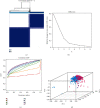
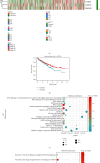
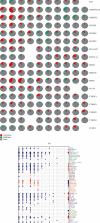
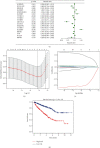
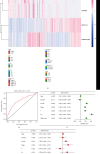


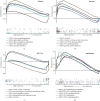

Similar articles
-
N6‑methyladenosine RNA methylation regulators participate in malignant progression and have prognostic value in clear cell renal cell carcinoma.Oncol Rep. 2020 May;43(5):1591-1605. doi: 10.3892/or.2020.7524. Epub 2020 Feb 28. Oncol Rep. 2020. PMID: 32323803 Free PMC article.
-
A novel 10 glycolysis-related genes signature could predict overall survival for clear cell renal cell carcinoma.BMC Cancer. 2021 Apr 9;21(1):381. doi: 10.1186/s12885-021-08111-0. BMC Cancer. 2021. PMID: 33836688 Free PMC article.
-
Identification of a Two-m6A RNA Methylation Regulator Risk Signature as an Independent Prognostic Biomarker in Papillary Renal Cell Carcinoma by Bioinformatic Analysis.Biomed Res Int. 2021 Feb 6;2021:4582082. doi: 10.1155/2021/4582082. eCollection 2021. Biomed Res Int. 2021. PMID: 33628782 Free PMC article.
-
[Research progress of m6A methylation modification in renal cell carcinoma].Zhonghua Bing Li Xue Za Zhi. 2024 Aug 8;53(8):876-882. doi: 10.3760/cma.j.cn112151-20231215-00417. Zhonghua Bing Li Xue Za Zhi. 2024. PMID: 39103278 Review. Chinese.
-
Role of m6A RNA methylation in renal resident cell injury.Zhong Nan Da Xue Xue Bao Yi Xue Ban. 2024 Nov 28;49(11):1757-1768. doi: 10.11817/j.issn.1672-7347.2024.230600. Zhong Nan Da Xue Xue Bao Yi Xue Ban. 2024. PMID: 40177759 Free PMC article. Review. Chinese, English.
Cited by
-
Deregulation of N6-Methyladenosine RNA Modification and Its Erasers FTO/ALKBH5 among the Main Renal Cell Tumor Subtypes.J Pers Med. 2021 Sep 30;11(10):996. doi: 10.3390/jpm11100996. J Pers Med. 2021. PMID: 34683137 Free PMC article.
-
N6-methyladenosine methylation in kidney injury.Clin Epigenetics. 2023 Oct 21;15(1):170. doi: 10.1186/s13148-023-01586-7. Clin Epigenetics. 2023. PMID: 37865763 Free PMC article. Review.
-
The emerging roles and mechanism of N6-methyladenosine (m6A) modifications in urologic tumours progression.Front Pharmacol. 2023 May 22;14:1192495. doi: 10.3389/fphar.2023.1192495. eCollection 2023. Front Pharmacol. 2023. PMID: 37284313 Free PMC article. Review.
-
Study on HOXBs of Clear Cell Renal Cell Carcinoma and Detection of New Molecular Target.J Oncol. 2021 Jul 8;2021:5541423. doi: 10.1155/2021/5541423. eCollection 2021. J Oncol. 2021. PMID: 34306077 Free PMC article.
-
Ghost authors revealed: The structure and function of human N6 -methyladenosine RNA methyltransferases.Wiley Interdiscip Rev RNA. 2023 Sep 6:e1810. doi: 10.1002/wrna.1810. Online ahead of print. Wiley Interdiscip Rev RNA. 2023. PMID: 37674370 Free PMC article. Review.
References
MeSH terms
Substances
LinkOut - more resources
Full Text Sources
Other Literature Sources
Medical
Research Materials
Miscellaneous

